Because you just never know when this info will come in handy… for full croc awesomeness:
Check Out A Deadly 350 Million Yr Old Salt Lake in Australia’s Outback
The Australian Outback is a lot like the American West — vast, beautiful, and lonely. Animals outnumber the people about 500 to one (depending on your source), and everywhere you look are canyons, deserts, and flat. Lots of flat … and a never-ending sky. But Australia’s outback is about 10 times larger than the American West — and millions of years older.
Once, around 350 million years ago, much of the Australian Outback was covered by a huge inland sea. Today, nothing is left of that ocean except huge salt flats that dot the landscape around Uluru (formerly known as Ayers Rock), Kata Tjuta, and Mount Conner — the three most recognizable features in the Outback.
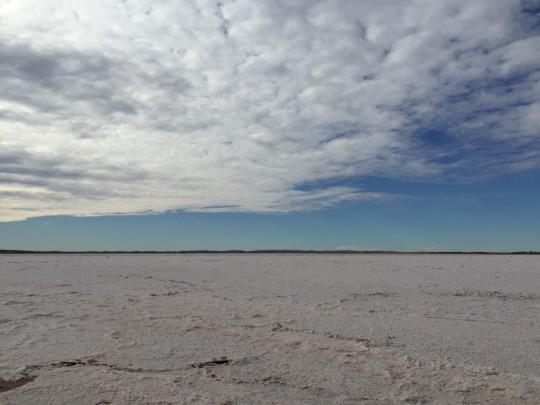
The wide-open landscape of the Australian Outback. (Photo: Paula Froelich)
Unlike Uluru or Kata Tjuta, Mount Conner, while still considered sacred by the local Aboriginal people, lies in the middle of a million-acre cattle farm owned by the Severin family. (The land was privatized in 1938, and all Aboriginals were moved off. But because Mount Conner isn’t as sacred as the other sites in the area, no one has come to claim it, so the land remains in private hands.) Located off the Peterman highway, a one-lane dirt road, many people call it “Fool-uru” because of its similarities to Uluru and its history.
“Back in the day, people would come from Alice Springs on the Peterman Highway — it was the only road out here from Alice Springs for years — and they would see Mount Conner and say, ‘Oh! Uluru!’, and turn around and go back home,” my friend and guide Stacy Beswisk laughed. “Many people never actually saw Uluru.”
These days, only the Severin family members have access to the top of Mount Conner (the youngest son was married there several years ago) but, as with Uluru, the drive around it is spectacular.
Related: G’Day Mate! How To Speak Australian
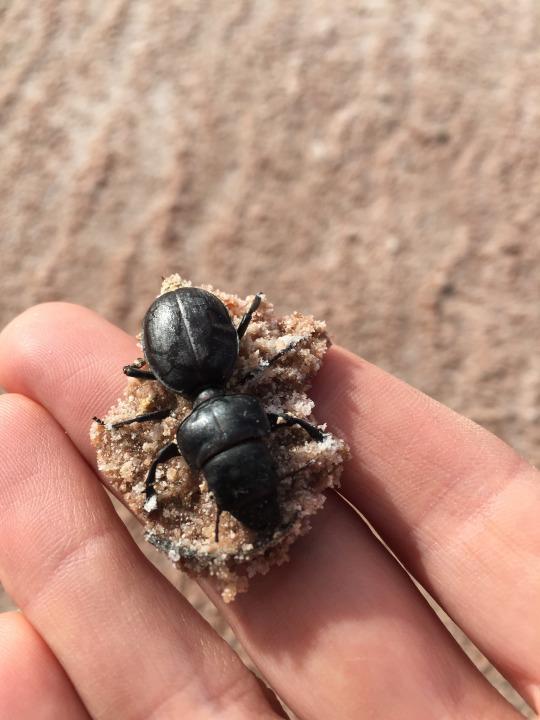
Mummified bug in the salt lake. (Photo: Paula Froelich)
Even more interesting is Lake Swanson, also on the ranch but about 10 miles away from Mount Conner.
Surrounded by salt bush and a few desert oaks, which Beswisk estimates are around 450 years old, the huge salt lake is all that’s left of the inland ocean.
“They used to mine salt here,” Beswisk said. “No more. … Now you can’t take it out of the country.”
Experience Uluru: Australia’s Iconic Spiritual Landmark (Without the 24 Hr Flight!)
Named Ayer’s Rock by colonists, Uluru is a massive sandstone monolith in the heart of the Northern Red Centre desert – in the southern most part of the Northern Territory.
While I’d visited Australia a few times [full disclosure: I almost married an Australian so had to make the trip several times, despite the hellacious 24 hour flight], I’d never made the 1,000 mile, Sydney to Uluru trek. In my defense, I was busy meeting the at the time, soon-to-be-future in-laws that never were. But it has always figured large in my mind and was number one on my Bucket List.
Related: G’Day Mate! How to Speak Australian
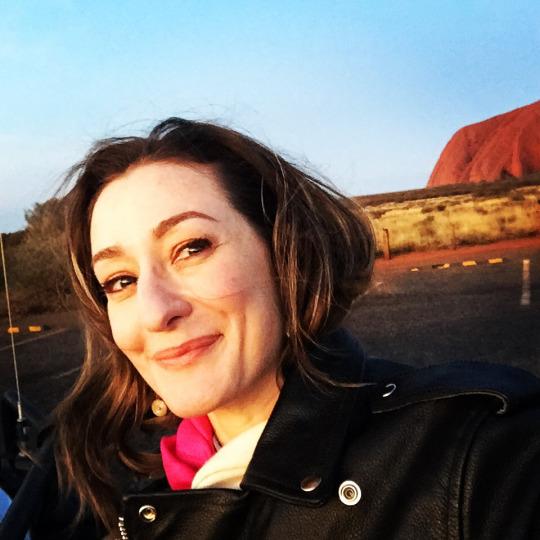
It’s not an Aussie selfie unless Uluru is in there.
So when I got the chance to visit the Outback, my first stop was Uluru.
Rising out of what seems like nowhere, Uluru is sacred to the local indigenous nation – the Anangu – and believed to be about 700 million years old. While it seems massive, rising 1,000 feet high out of the ground, like an iceberg, what you see is just the tip.
“It is a huge solid rock,” my guide Ryan Clark, told me. “It is embedded in the ground. Sometime about 300 million years ago it turned on its side which is why the sandstone (stripes) look like they are going up and down instead of left to right.”
Related: Go Now: The New Seventh Wonder of the World That’s Empty
Dually listed as a World heritage Site for both its cultural and geological significance, Uluru went through a dark period starting in 1958, when the government took it and the surrounding land from the Anangu people and set up an air strip with motels directly next to the rock (on sacred ground). Tourists were allowed to climb Uluru, walking onto land that the Anangu considered holy. But, on October 26th 1985, the government returned the land to the Anangu people – this year is the 30th anniversary of Australia handing back the land to the indigenous owners – and the motels were moved several miles away. Today there are four resorts around Uluru, but at a respectful distance.
G’Day Mate! How to Speak Australian
Australia is an English-speaking country — but, like with England, there are a lot of differences between here and there. So many, in fact, that if you hang with the locals at a pub in the outback, you won’t be totally off base if you sit for a second and wonder, “Just where the hell am I, anyway?”
Related: Lost in Translation: Whose Language Is It Anyway?
Because quite often, Australian English actually needs a translation.
For example, where you might say, “Sharon’s been working very hard, so when we gave her her birthday present she started crying. She needs to toughen up a bit.” — an Australian would translate that to: “Shazza’s been flat out like a lizard drinking. When we gave her a bidet prezzie, the sheila started crying. She needs to drink a cuppa cement.”
Confused? Don’t worry. I’m here to help so that when you take your big trip down under, you’ll fit right in! Watch the video and then, just for fun, translate your thoughts into Australian in the comments below.
The Eerily Beautiful Ghost Towns and Fjords of Greenland
When I went to Greenland in April, there was nothing I was looking forward to more than sailing through the country’s fjords and seeing the polar ice cap up close — plus possibly spying a polar bear. These things are all beautiful, but each also has a darker history.
The (disappearing) ice sheet, which is around 110,00 years old, covers 80 percent of the country and is 3 kilometers thick at its deepest point, but is generally 2 kilometers thick. The glaciers spread over the middle of the country and flow outward, breaking off in the fjords, which are filled with icebergs and sheets of floating ice called floes.
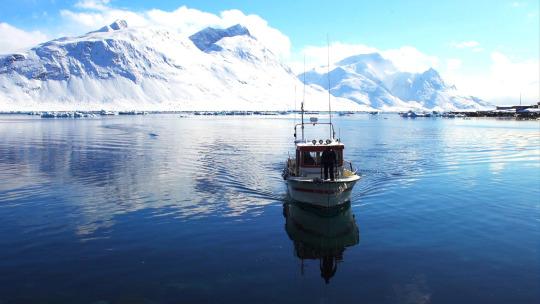
Sailing around the fjords is dangerous. Just as in “Titanic,” only the tip of the bergs flowing around you are visible. “You have to be very, very careful when sailing around here,” said my guide, Yakob Mathiassen. “But we are fine — we have an Inuit boat driver.”
Related: The Newest Gastro Hot Spot Is… Greenland? No, Really!
It’s beautiful, but global warming is changing things. The ice sheet decreased 16 percent from 1979 to 2002, and as a result, polar bears — which generally stay to the very north of the country — have been coming south.
“There was one they had to shoot last year because it got too close to Nuuk City central,” Mathiassen said. “The theory is he came down and around the tip of the country on an ice floe with the current.”
(Fun fact: If you run into a polar bear and you don’t have a weapon, do not run away. They can run 40 miles per hour, so you can’t outrun them — you have to try to distract them. To do so, you have to get naked. Seriously. Take a piece of clothing off. Drop it on the ground and back away slowly. Then take another item off and back away slowly. Repeat until you are naked (ish) and then run. “Polar bears are very curious,” Mathiassen said. “They will inspect, bite, or play with objects they come across. Leave enough clothes for them to forget about you and run as fast as you can.”)

As you sail along the coast of Greenland, you also see picturesque but empty settlements. In the beginning of the 20th century, Nuuk was not the capital. At that time, most of the country’s population, which now stands at 50,000, was in small settlements which ranged from a few families to a thousand people dotted along the coast. People lived by hunting and foraging what they could. Supplies, mail, and even schools were shipped in.
The Hottest New Foodie Scene is in … Greenland? No, Really!
When someone brings up the hottest gourmet, gastronomic foodie scenes in the world, places like Paris, San Francisco, or Madrid come to mind. But ever since Noma, in Copenhagen, was named best restaurant in the world in 2010 (and several times after that), the focus has moved north. And even farther north than Scandinavia is Nuuk, Greenland, which has two world-class gastronome restaurants in a town that has a population of 17,000 people.
There is Nipisa, on the edge of the Labrador Bay, andSarfalik, located in the Hotel Hans Egede — the four-star hotel of Greenland (yes, there is one). The chefs at both are Danish, but Bjorn Johanssen, the chef at Sarfalik, is the new Wylie Dufresne (aka molecular gastronomy genius) of the Arctic.
Related: Taste-Testing Greenland’s Finest Microbrews
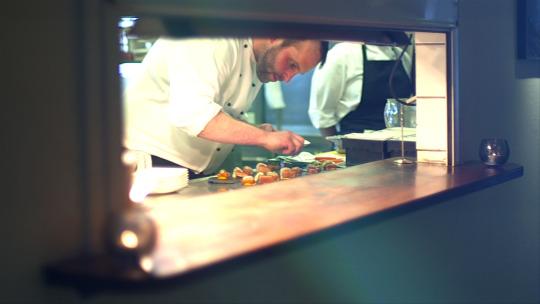
Bjorn Johanssen, hard at work.
Luckily, while I was snowed in in Greenland, I stayed at the Hotel Hans Egede and got to eat at Sarfalik several nights, sampling dishes made with local meats.
“In Greenland it’s OK to hunt whale and seal,” Johanssen explained. “We all hunt here, and we use everything on the animal.” The local meat is also cheaper. As expected, not much grows in Greenland, and despite a few greenhouses in the southern part of the country, most fresh vegetables have to be shipped or flown in at considerable cost.
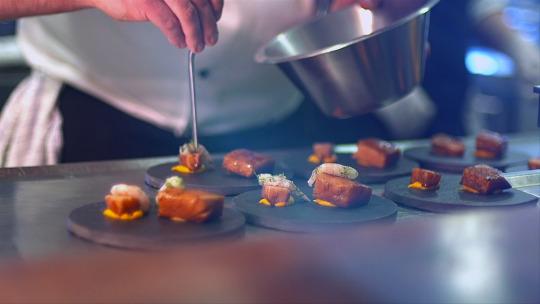
The first of nine courses … it was a long night.
Johanssen has a nine-course tasting menu — which combines Arctic fowl, duck, muskox, lumpfish, lumpfish roe, seal, whale, and whale skin — some served with something called “hot shell foam” yogurt, shaved ice, and frozen berries. Every now and then there will be polar bear meat (you read that right), but “it’s not so tasty,” Johanssen said.
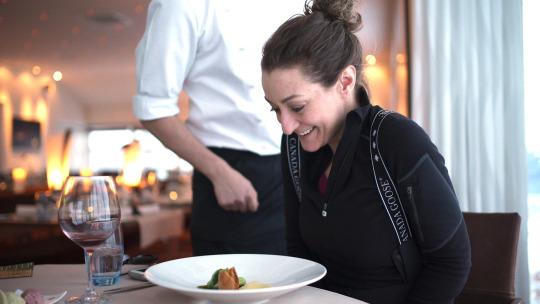
About to dig in to some serious yumminess.
Final verdict: Seal, meh. Whale — tasty! Whale skin: tough and gummy. Muskox: delicious — like lamb and beef, but better! If you get the chance, eat it. Greenland, the cuisine capital? Who knew?
The Craziest Dance/Customs in the World are 10K Years Old and Still Being Practised
One of the most important things in a culture is its folklore — tales that have been passed down over the centuries from family to family that shape the morals and fabric of a society. In Western society, these folktales have been watered down via Disney or the Internet, but in a secluded country like Greenland, which was isolated for so long from traditionally modern society, the tales are not only still told verbally, but also performed.

The story telling isn’t just about the dance. (Photo: A Broad Abroad)
At the National Theatre of Greenland, I met the principal, Makka Kleist, and her dance student Kimmernaq Kjeldsen.
“This is a very old culture,” Makka told me. Continue reading
The Best Beer in the World is in Greenland? No, REALLY!
Anybody who knows me knows I don’t drink vodka. I don’t do tequila. And I’ve never been a big fan of anything that comes with a garnish. I am, however, a beer girl. Raised in Cincinnati, a town with German roots, I have a deep love of hops, and over the years my tastes have been refined fromHudepohl and Schlitz to craft beers. Don’t get me wrong — when stuck on a riverboat for a bachelorette party in, say, Austin, Texas (thanks to my sister Emily), I will still happily down a Bud, a Coors, or a Schlitz. But I have learned to appreciate the fine craft of beer making and love a small-batch brew. So on my trip to Greenland, when I heard there was a craft brewery in town, I made a beeline for it.
Related: Finger Pulling and Kick the Seal — Welcome to the Arctic Games!

The Godthaab Bryghus brewery is in a building that conveniently also houses a dive bar called Daddy’s. While “Daddy” is a great guy named Gert, the actual brewery is run by Mikael Sorenson, who swears that the beer there is made with glacier ice that is at least 2,000 years old.
“Yes, we have men who go out onto the ice and cut slabs off the glaciers for us and bring them back here for our beer,” Sorenson said.
[Side note: Apparently ice cutting is a big business. Down the street is an ice cream shop that also uses 2,000-year-old ice. “Ice cream in Greenland?” you may be asking. “Isn’t it cold enough?” No. It’s not. Greenland has the second largest ice cream consumption per capita in the world, second only to Finland. Go figure.]
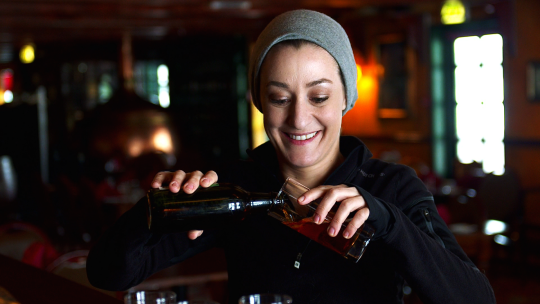
While there are no official stats on how much beer is consumed in Nuuk, Greenland’s capital, judging by the crowds in the bars and the continual snow, I’d say it ranks right up there. And frankly, I can’t say I blame them — the weather is rough (see previous episode: “Snowmageddon 2015: Cabin Fever Hits Hard in Greenland”), and the beer is delicious. At the time I visited, there were five beers on tap, including the Musk Ox, the Eric the Red, and the Polar Bear (they like to name the beers after local animals). And here’s a tip: While they are all delicious, if you ever find yourself at Daddy’s in Nuuk, ask for Gert and Mikael and get them to give you the unfiltered versions of all the beers. They may smell like dirty feet, but they taste like heaven.
An Homage to the Shining: It Got Weird during Snowmaggeddon 2015 in Greenland
As anyone living on the East Coast can tell you: This past winter was rough. I thought I’d seen it all — snow for days, snowdrifts several feet high, icy sidewalks — you name it. But apparently, in the Arctic Circle, what we call Snowmageddon is just another Tuesday in April. Or May. Or, you know, whenever. And when you’re in the Arctic Circle, all plans are speculative.
I went to Greenland in April, with dreams of dog mushing, ice fishing, Northern Lights viewing, and hanging with polar bears and Inuit, possibly in an igloo. I was supposed to fly into the capital city of Nuuk (population 17,000) for a few days before heading north to Illulisat and my adventures. Little did I know a blizzard was on the way. And by blizzard, I mean a snow dump that lasted three and a half days — as in, it didn’t stop snowing for one hot second for three and half days. All flights were canceled and my A Broad Abroad crew and I were stranded — granted, we were stranded at the lovely Hans Egede Hotel, but when the power goes out intermittently for three and a half days, all hallways, no matter how nice, get real creepy, real fast.
Now, I don’t know if you know this, but there’s not much to do in a town of 17,000 people — especially when you can’t walk anywhere due to low visibility and spotty electricity. But, just in case you are ever in the same situation, I have made a handy-dandy list of things to do when snowed in — and, even better, I captured all the randomness on video. So, watch the video and read the list.
1. Make new friends. Or try to…
Just so you know, there are three — count ’em, three — guys on Tinder in Nuuk. And not one of them wanted to hang with me … possibly because in my not-so-subtle message I asked for an interview instead of a date, typing, “Hey! Just in town for a hot second with a film crew — want to be on camera and talk about how to date in Greenland???”
Related: How to Dress for the Arctic in 13 Easy Steps
2. Ask for suggestions of what to do on Twitter and Facebook
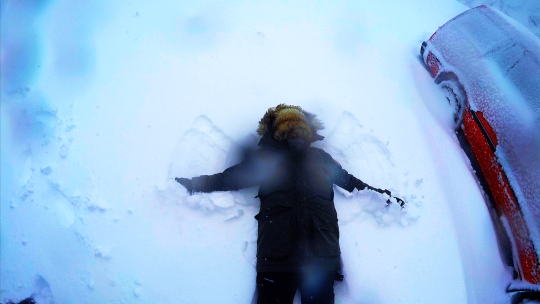
Which leads to things like making snow angels (and getting snow down your pants), building snow caves (and getting snow down your pants), snowball fights with strangers (fun fact: Locals in Greenland are much, much better at snowball fighting than anyone from 49 out of 50 United States — funny, that), and karaoke/sing-alongs with the guy playing piano at the hotel bar. A lot of karaoke and sing-alongs.
3. Have a drink. Or five.
Speaking of hotel bars, when the sun is blocked out for days on end and every hour bleeds into the next, there’s not much else to do but drink. Thankfully, Greenland has a lively craft brewery scene, and the beer is not only delicious but locally made (unlike everything else in the country, which is imported), so it isn’t insanely expensive.
4. Just give in to cabin fever — start talking to yourself and filming homages to The Shining

All work and no play makes Paula a dull girl.
Finger Pulling, Head Pulling and Kick the Seal: The Craziest Sports in the Arctic Games
When I first heard about the Arctic Winter Games, my head immediately filled with snowboarding, skiing, dog mushing, and possibly ice fishing. But that’s not all that happens…
Occurring every two years, the Arctic Winter Games are the Olympics for athletes in the places that inhabit the Arctic Circle: Canada, Russia, Alaska, and Greenland. Within the games are the Arctic Sports, a series of competitions that derive from Inuit culture and survival techniques that the Inuit needed to have when hunting or camping out on the ice for weeks on end. While now performed inside a warm gym, some of the sports — while featuring some seriously dubious names — can still be dangerous: Greenland’s Prime Minister Kim Kielsen is missing the middle finger on his left hand thanks to a game called the Finger Pull.
Related: How to Dress for the Arctic in 13 Easy Steps
Which leads us to the list of Arctic Sports:
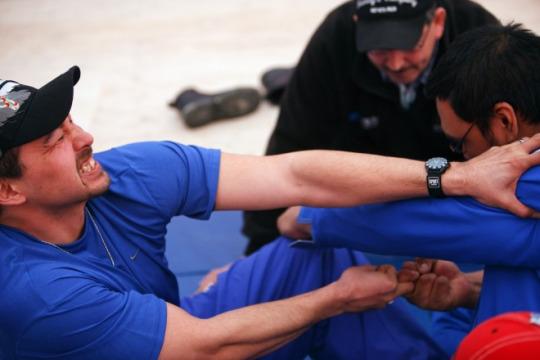
(Photo: Sol Neelman)
1. The Finger Pull
According to the Arctic Winter Games website, finger pulling occurs when “Two competitors sit on the floor facing each other and lock middle fingers. Competitors pull steadily at the fingers while bracing their opposite hands on their opponent’s ankle. The object is to pull the opponent over or touch the opponent’s hand to one’s chest.” Again, this can be oddly dangerous.
2. The Kneel Jump
“The competitor begins in a kneeling position, with buttocks resting on one’s heels, toes pointed backward, and hands on knees. From this position, he then jumps as far forward as possible, lands on his feet in a squatting position, and maintains balance.”
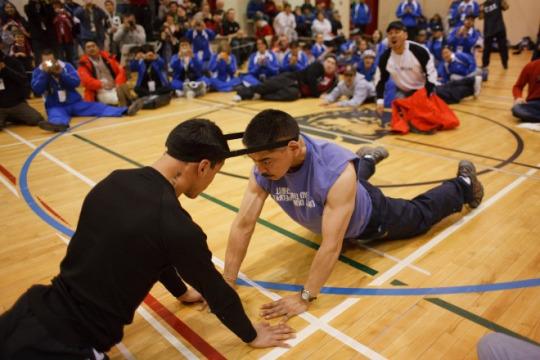
(Photo: Sol Neelman)
3. The Head Pull
“Two competitors lie on the floor, their stomachs facing each other. A looped band is placed over the back of each head above the ears. Rising to a ‘push-up’ position with only hands and feet touching the floor, the athletes pull with their heads, bracing their hands out in front and using their whole body strength to pull steadily backward. The object is to pull the opponent over a line that is drawn between them. (Males only)”

(Photo: Sol Neelman)
4. The High Kick — aka Kick the (Stuffed) Seal
“The competitor starts with a running or standing approach with feet no more than shoulder width apart at take off. The target must be clearly struck while both feet are parallel. Maintaining balance and control, the competitor must land on both feet at the same time, no more than a shoulder width apart.”
Related: Greenland: Where Polar Bear, Seal and Fox Fur Is in
5. The One-Hand Reach
“In the starting position the competitor must brace himself with the elbow of the balancing arm tucked into the body. The competitor begins by lifting his feet off the floor while balancing on his hands. With one hand the competitor reaches up to strike the target while maintaining his balance on the other hand. The striking hand must touch the ground before any other part of the body does so. (Males only)”
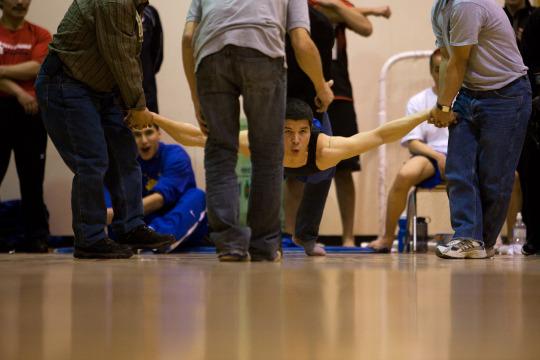
(Photo: Sol Neelman)
6. The Airplane
“The competitor lies on the floor, face down, with arms straight out in an ‘iron cross’ position. Four assistants lift the competitor two to three feet off of the floor and carry him forward at a constant speed. When the competitor’s body or arms begin to sag, he drops. Longest distance before dropping wins. (Males only)”
7. The Triple Jump
“Using a running or standing start, the competitor completes three consecutive jumps. Feet must stay no more than shoulder width apart. The shortest distance from the back of the starting line to the nearest point touched by any part of the competitor’s body wins.”
While there are more self-explanatory Arctic Sports – including arm pull, stick pull and other jump categories, these were the most… illuminating of the bunch. In 2016, Greenland will host the games solo for the first time ever, so Arctic champion Tonny Fisker took me to the local high school gym where he and other athletes were training… Check out the video above for all the arm pulling, head pulling, stuffed seal kicking, and airplaning in action. It’s pretty fascinating. I swear.
